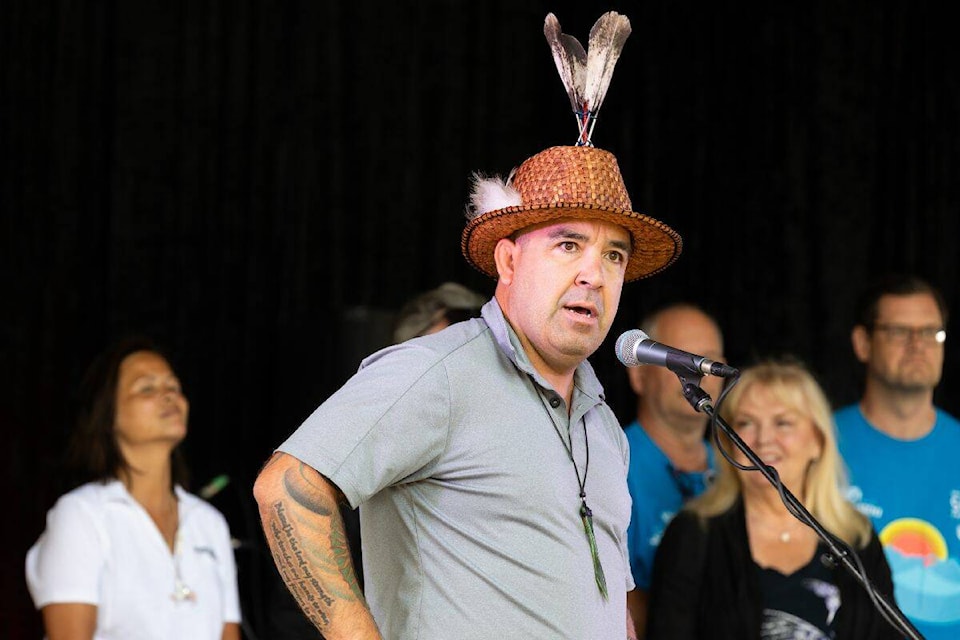A new biofuel facility proposed for Semiahmoo First Nation Land is a good thing for the community, according to SFN chief Harley Chappell.
“(The project) is true sustainability, it’s local sustainability – it’s not just… taking our waste and shipping it off, becoming someone else’s problem, so we’re able to manage that and do that locally and ultimately, provide for the residents of South Surrey when it comes to putting the natural gas back into the grid,” Chappell said Monday (Oct. 30).
News of the planned plant, which would turn organic waste into natural gas, has raised concerns with many local residents who are opposed to the idea. A rally held at Peace Arch Park Oct. 29 drew hundreds of protesters, who cited worries about the environmental impact of the proposed plant, along with potential health risks, increased traffic and location, odour, air pollution, property devaluation and noise pollution.
READ ALSO: Peaceful rally opposing proposed biofuel facility held at Peace Arch Park
The proposed facility, which, it is estimated, will eliminate around 55,000 tons of greenhouse gas emissions, divert 70,000 tons of organic food waste from area landfills and incinerators, generate 3.5 million gigajoules of renewable natural gas (RNG) and help avoid the use of some 22,000 tons of chemical fertilizers, will also create jobs and revenue for the First Nation.
Chappell, who is known for advocating the importance of being good stewards of the environment and reviving the local shellfish population, said the nation has done its due diligence with the project.
“We wouldn’t, obviously, have the approval from (the) First Nations Health Authority and Fraser Health when it comes to air quality, so it is kind of troubling that these citizens are coming forward and some of the things they’re saying,” he said.
“It’s preposterous to think that we’re not going to take into consideration all the environmental impacts, both positively and negatively.”
Chappell said SFN has looked at other possible projects for the area, but noted they are limited by the service agreements they have with the City of Surrey and the City of White Rock.
READ ALSO: SFN, White Rock re-establish water connection
“When we look at different opportunities with the limited capacities that we’re given, then we’re not always able to do all the projects that we hope to do – we’re a little bit handcuffed when it comes to that,” Chappell said.
“We are looking to do more public engagement and we’re hoping to meet with local politicians and local governments, just to again, address some of their concerns or issues. I’ve asked our administration girls at the (SFN) office how much has the community reached out? Has anybody reached out? And there’s been very little… I heard one of the local councillors had something to say and she hasn’t reached out to us at all. It’s kind of troubling when nobody’s reaching out to the nation.”
Chappell noted the SFN are at a unique point in their history.
“As our territory’s been developed, we were never at a place – whether it’s local, provincial or federal government – we were never at a place to come and have a conversation or even a discussion with Indigenous communities and even with regional growth strategies and Metro Vancouver’s planning – we were never included in those as reserves,” he said.
The SFN are at a place now where they are looking to expand, and bring economic opportunities into their community for many different things, Chappell explained.
“For us, we see this as a positive thing. One of the biggest contributors for CO2 emissions in South Surrey is both the border crossings that we’re right here at. We’ve dealt with that – that was land that was expropriated from reserve lands to make the highway, to make the border, and obviously now we deal with those repercussions,” he noted.
“So for a neighbour to come from across the way and say ‘Oh my goodness, this is such a horrible thing’ – we’ve been living with this for generations and we continue to.”
Chappell said he and the SFN will continue to look for every opportunity to improve environmental conditions within their territory, as that is their responsibility and always has been.
“We need to look at the data. We need to look at the science. We need to look at the approvals from multiple different levels of government and the support from multiple different levels of government given to get to this point,” he said.
“There are concerns and that’s fine, but from our lens, this is a good opportunity. We can bring this into the community, we can do some good. We can have this time to be able to really support our neighbours.”
